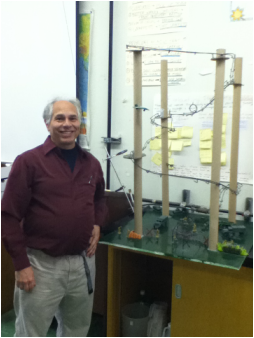Achievements/ Samples of Work

This picture represents my two greatest achievements at Alameda Community Learning Center. As you can see, this is my roller coaster. This was a project that took literally days of my time. My partner, Ginger and I were huddled into the conference room making non stop changes for weeks. We suffered numerous headaches, hot glue burns, and frustration from people stealing our equipment/ ideas. At the end though, it won because it was the only coaster that could actually bring the ball bearing all the way to the end. Which is humorous because some teams actually bought roller coaster track online, and theirs did not work, as ours prevailed. The second part of the picture is of course, Milt Friedman. The reason he is one of my greatest achievements is because I am currently taking 3 of his classes as a senior. That's two math classes, and one science class that should have been out of the way sophomore year. We see a lot of each other during the day, and although I goof around in his class a lot, we have a very strong learner facilitator relationship. Without his help, I would not be able to pass these difficult subjects in which i have enormous trouble dealing with, or graduate. Thank you once again, Milt, for dealing with 2011 winner of the "Most Outlandish Public Disturbances" award.
Algebra in Real Life Situations
This is a project I had to do for Algebra 2. It is one of my greatest accomplishments at ACLC because I took a long time working on it, and got a very good grade on it.
Estimating Population Size:
Mark and Recapture
Mark and recapture is a method commonly used in ecology to estimate population size. This method is most valuable when a researcher fails to detect all individuals present within a population of interest every time that researcher visits the study area. There are different formulas for estimating population size. They are all used algebraically to represent population size. This is a prime and significant example of Algebra used in every day common life.
Lincoln and Petersen Method of Analysis:
N= Mc/r
Where:
N= Estimate of total population size
M= Total number of animals captured on 1st visit
C= Total number of animals captured on 2nd visit
R= number of animals captured on first visit that were then recaptured on the second visit.
Derivation of the Lincoln Petersen Method
R/m = C/n
It is assumed that all individuals have the same probability of being captured in the second sample, regardless of wither they were previously captured in the first sample
Sample Calculation
A biologist wants to estimate the size of a population of adorable brown mice in a field. She captures 10 adorable brown mice and marks their backs with paint. On the next visit, she captures 15 mice. 5 of the 15 mice have paint on their back, indicating that they are recaptured animals.
N= Mc/R = 10(15)/5 = 30
A Refined Form
A slightly better estimate of population size can be obtained with a modified version of the first formula above. This modified formula reduces bias in the population estimate:
N= (M+1) (C+1)/R+1 – 1
N = Estimate of total population size
M = Total number of animals captured and marked on first visit
C = Total number of animals captured and marked on the second visit
R = Number of animals captured on the 1st visit that were recaptured on the 2nd visit.
An approximately unbiased variance of N, or var(N), can be estimated as:
Var(n)=(m+1)(c+1)(m-r)(c-r)
Divided By:
(r+1)(r+1)(r+2)
Estimating Population Size:
Mark and Recapture
Mark and recapture is a method commonly used in ecology to estimate population size. This method is most valuable when a researcher fails to detect all individuals present within a population of interest every time that researcher visits the study area. There are different formulas for estimating population size. They are all used algebraically to represent population size. This is a prime and significant example of Algebra used in every day common life.
Lincoln and Petersen Method of Analysis:
N= Mc/r
Where:
N= Estimate of total population size
M= Total number of animals captured on 1st visit
C= Total number of animals captured on 2nd visit
R= number of animals captured on first visit that were then recaptured on the second visit.
Derivation of the Lincoln Petersen Method
R/m = C/n
It is assumed that all individuals have the same probability of being captured in the second sample, regardless of wither they were previously captured in the first sample
Sample Calculation
A biologist wants to estimate the size of a population of adorable brown mice in a field. She captures 10 adorable brown mice and marks their backs with paint. On the next visit, she captures 15 mice. 5 of the 15 mice have paint on their back, indicating that they are recaptured animals.
N= Mc/R = 10(15)/5 = 30
A Refined Form
A slightly better estimate of population size can be obtained with a modified version of the first formula above. This modified formula reduces bias in the population estimate:
N= (M+1) (C+1)/R+1 – 1
N = Estimate of total population size
M = Total number of animals captured and marked on first visit
C = Total number of animals captured and marked on the second visit
R = Number of animals captured on the 1st visit that were recaptured on the 2nd visit.
An approximately unbiased variance of N, or var(N), can be estimated as:
Var(n)=(m+1)(c+1)(m-r)(c-r)
Divided By:
(r+1)(r+1)(r+2)
